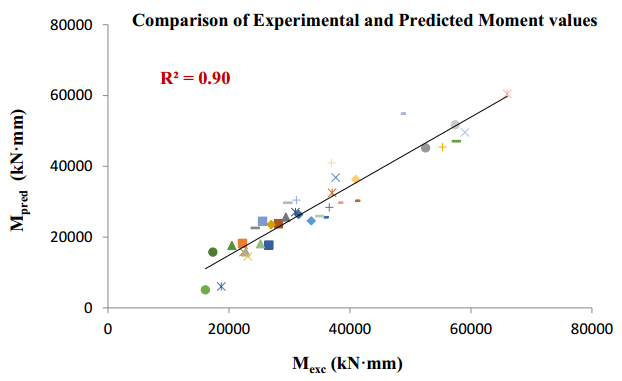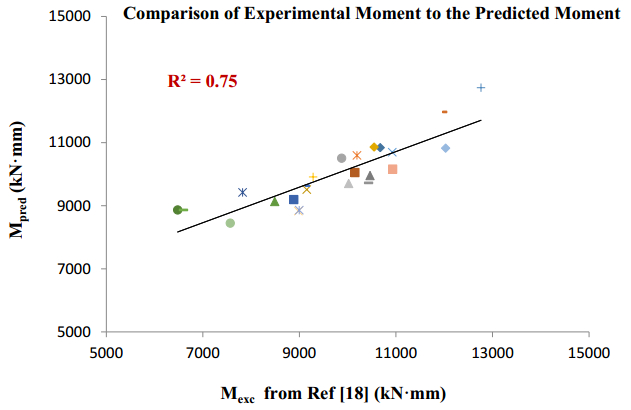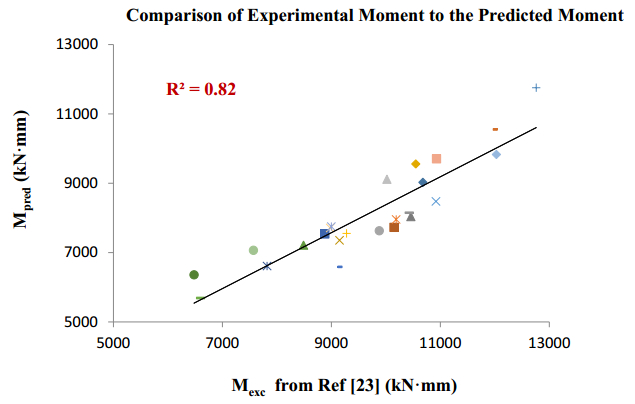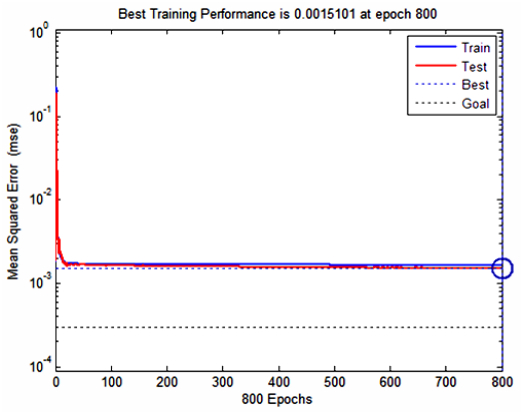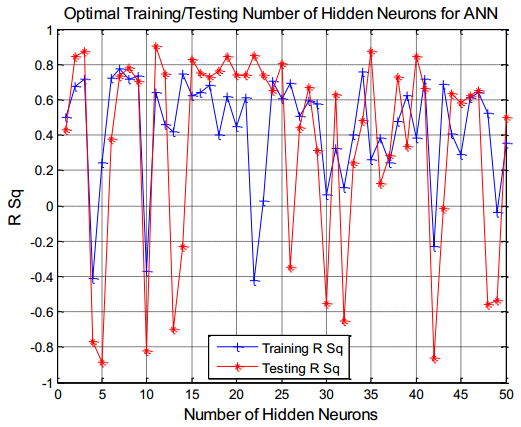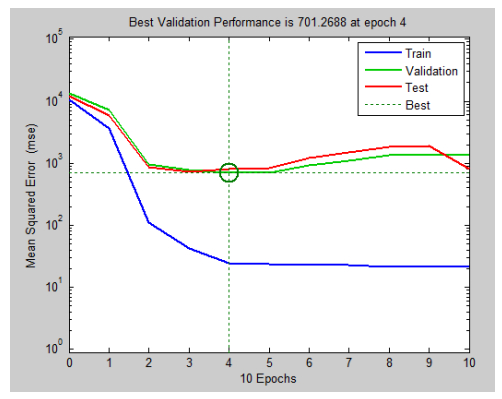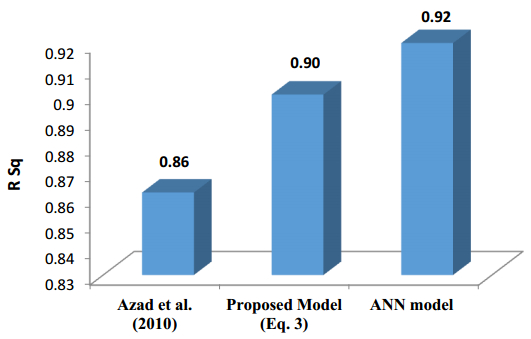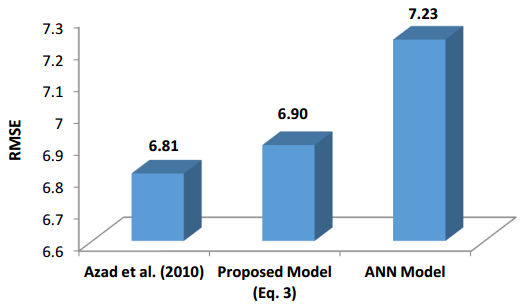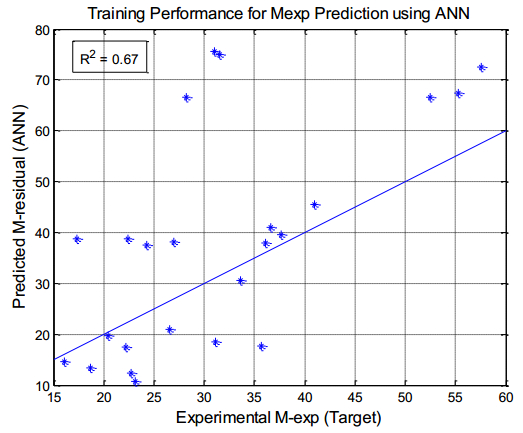1. Introduction
Cement concrete has clearly emerged as the material of choice for the construction of a large number and variety of structures in the world today. This is attributed mainly to low cost of materials and construction for concrete structures as well as low cost of maintenance. Use of high water cement ratio (w/c) in a high early strength cement led to serious problems with durability of structures, especially those subjected to severe environmental exposures [1].
Corrosion of reinforcing steel bars (rebars) in reinforced concrete (RC) structures is a major reason for structural durability degradation. When the carbonation or the concentration of chloride ion on steel surface reaches a critical value the oxide film can be depassivated and corrosion can be initiated. It has been well established that the corrosion products formed on the concrete-steel interface can lead to volume expansion and eventually cracking of concrete cover. Corrosion can also cause reduction of the cross sectional area of rebars and significantly affect their mechanical properties, including the yield and ultimate strengths and ductility [2].
Intensive research has been carried out on the influence of rebar corrosion on the structural performance of RC structures, especially the reduction of the load carrying capacity of corroded RC beams, over the recent decades. It was found that the obtained amount of reduction from these research activities varied largely. For example, Torres-Acosta et al. [3] observed a 60% reduction in the flexural load carrying capacity at about 0.19 of section loss ratio while Mangat and Elgarf [4] found a 24% reduction at almost the same corrosion degree. Amongst the three effects caused by rebar corrosion, namely the reduction of rebar-sectional area, degradation of mechanical properties of rebar, and loss of rebar-concrete bond, no consensus has been reached on which one is the primary reason for the reduction of the load carrying capacity of RC members and structures [4,5,6]. It was also found that the accelerated corrosion process, as used in most of the investigations, has quite different effects from the natural corrosion process on the structural behavior of the RC members and structures [7].
A review on the mechanism of reinforcement corrosion, its initiation, progress and factors that expedite the process of reinforcement corrosion, techniques utilized to monitor reinforcement corrosion and methodologies that are utilized for the prediction of remaining service life of structures are also presented [8,9]. Wang and Liu [10] proposed a simplified methodology for the evaluation of the residual strength of corroded reinforced concrete beams. Wang et al. [11] revealed a significant reduction in the bending strength when the corrosion rate was increased. Torres-Acosta et al. [12] concluded that the flexure load capacity diminished mainly due to the formation of pits on rebar surface, which were as deep as 73% of the original reinforcement diameter. Xia et al. [13] studied the effect of chloride-induced reinforcing steel corrosion on the flexural strength of reinforced concrete beams. Wang and Chen [14] developed a finite element model to further investigate the behavior of corroded reinforced concrete beams. Tachibana et al. [15] observed different types of failure including flexure, shear-compression and bond-shear and also reported a significant reduction in the flexure strength of corroded beams. Imam and Azad [16] conducted a test on corroded and un-corroded beams to find the shear capacity and behavior of corroded reinforced concrete beams based on which strength prediction model has been developed. Cairns et al. [17] investigated the specific aspects of structural performance including stiffness and deflection under service loads, ultimate flexural and shear strengths and deformation capacity at failure, when the beam were subjected to reinforcement corrosion. Ahmad [18] reported a detailed study on the effect of corrosion on flexural strength of reinforced concrete beams supported by comprehensive experimental observations. Ortega and Robles [19] measured crack widths and vibration natural frequencies with a stimulating effect of the corrosion mechanism on the structural reinforcement. Shannag and Al-Ateek [20] observed a significant reduction in flexural strength of high performance fiber reinforced concrete beams when subjected to different degrees of corrosion. Hawileh et al. [21] investigated specifically the effect of corrosion rate on the degradation of monotonic mechanical properties and low-cycle fatigue life of BS4449/2005 Grade B500B steel reinforcing bars. Three different corrosion levels were selected in their studies, mainly 9–10%, 13–15%, and 19–20% measured as mass loss of un-corroded bar specimens. The authors observed that the material's yield and ultimate tensile strengths and ductility, in addition to the fatigue life and the total dissipated energy of the steel bars, were reduced with increasing corrosion damage levels.
Several researchers have focused towards developing empirical correlations in view of predicting the service life of corroded structures [4,18,19,22-25]. Torres-Acosta et al. [26] developed an empirical relationship between the residual load capacity of a reinforced-concrete element and the degree of reinforcement radius loss by corrosion was estimated, and a second empirical relationship between the surface crack width and the reinforcement radius loss based on available experimental data.
In recent time, several researches illustrating the prediction work using an empirical method does not give much confidence to the researchers to check its applicability contradicting towards producing a more generalised solution. However, the studies are being carried out towards predicting the residual strength parameters using soft computing techniques (ANN, GA, Fuzzy Logic, SVM, etc.) which depicted a substantial enhancement in the predicted outcome and has proved to be a more reliable approach.
With the limitations in the experimental and theoretical methods, the quest for cost-effective, easy to use and adaptive models that offer scalability and efficient generalization capability to new cases continues. With the huge amount of data generated from various experiments over the years, robust data mining techniques that are based on computational intelligence (CI) and machine learning paradigms are hypothesized to be capable of overcoming the limitations of the conventional methods [27]. Artificial neural networks (ANN) are well established technologies being adopted in a variety of application ranging from pattern recognition to optimization. One of the attractive features of ANN is their ability to perform non linear, multi dimensional interpolations. This feature of ANNs makes it possible to capture the existing non linear relationships between input and output parameters [11]. ANN is the most commonly used of the CI techniques in various engineering application areas [28,29]. Since the performance of a model is determined by the nature of the problem (represented by data), there is no guarantee that using a more sophisticated algorithm will perform better [30]. Though ANN has been applied in modeling other civil engineering problems, they have not been adequately applied to the problem of estimating the residual flexural strength of corrosion-damaged RC beams, which is the focus of this paper. Considering the capability of ANN to handle more complex and non linear behavior in natural circumstances like corrosion etc, the present study is focused towards predicting the residual flexural strength of corroded reinforced concrete beams using Artificial Neural Network (ANN) tool with the aim of obtaining a generalised and optimized model.
A set of pragmatic guidelines for designing ANN for engineering applications were proposed by Rafiq et al. [31]. Nowadays, several researches are being focused towards using ANN as an efficient technique towards ensuring its applicability in civil engineering sections. Bai et al. [32] presented a neural network model that predicts the workability of concrete with cement replacement materials. The results of their neural network model were comparable to experimental results and illustrated how neural networks can be used to accurately predict the workability parameters.
Moreover, Oreta et al. [33] studied the application of artificial neural networks (ANN) to predict the confined compressive strength and corresponding strain of circular concrete columns. Erdem [34] investigated the application of artificial neural networks (ANN) to predict the ultimate moment capacity of reinforced concrete (RC) slabs in fire. An ANN model was built, trained and tested using 294 data sets for slabs exposed to fire. It was shown that ANN model predicted the ultimate moment capacity (Mu) of RC slabs in fire with high degree of accuracy within the range of input parameters considered. The moment capacities predicted by ANN were in line with the results provided by the ultimate moment capacity equation.
Tsai and Hsu [35] evolved a model of damage diagnosing for RC structures using the ANN technique. The network learning procedure showed that the rate and the accuracy of the convergence are acceptable while the test results showed that the technique is efficient for the problem. ANN has been used to predict the shear strength [36], deformation capacity [37] and shear resistance [28] of various shapes of RC beams. Adhikary and Mutsuyoshi [38] also developed artificial neural network models (2 Models) for predicting the ultimate shear strength of steel fiber reinforced concrete (SFRC) beams using the experimental data from the literature. Sharifi and Tohidi [39] have used ANN method to predict the load carrying capacity of deteriorated steel beam under the effect of pitting and uniform corrosion. On the other hand, Abdalla and Hawileh [40] presented a model for predicting the low-cycle fatigue life of steel reinforcing bars using Artificial Neural Network (ANN). Following which, a parametric study had also been carried out to investigate the effect of maximum strain and strain ratio on the fatigue life of steel reinforcing bars. They concluded that both the strain ratio and the maximum strain have significant effect on the low-cycle fatigue life of such bars, especially at low values of maximum strain and their effect should be considered in both analysis and design. Naser et al. [41] presented an alternative approach to predict fire resistance of CFRP strengthened T-beams. Based on the experimental and Finite Element studies, ANN models were developed to predict the fire endurance of RC T-beams strengthened with CFRP laminates when subjected to elevated temperatures. The predicted fire endurance and time to failure were compared with obtained experimental and validated FE simulation results. Strong correlation between the predicted ANN, experimental, and FE results was obtained. Design charts were also developed to be used as preliminary guidelines to aid designers in selecting the required insulation thickness for specific insulation systems and fire exposure scenarios. It was concluded that the developed and validated ANN could be used as a computational tool in the analysis and design of RC beams strengthened with CFRP plates and subjected to thermal fire loadings.
On a similar note, Abdalla and Hawileh [42] developed seven artificial neural network (ANN) models to predict the fatigue life of steel bars based on the concept of energy dissipation. Since, the fatigue life of steel reinforcing bars depends on the energy dissipated during cyclic loading. Steel bars play a major role in energy dissipation in reinforced concrete structures under low-cycle fatigue loading during earthquakes. They concluded that the developed ANN models can be used to reliably predict fatigue life of steel reinforcing bars based on energy as input parameters. Moreover, Abdalla et al. [43] also employed Artificial Neural Network (ANN) to predict the optimum design parameters for wall systems while avoiding the demanding iterative process. The developed ANN model were found to be very accurate in predicting the non-dimensional optimum design parameters related to post-tensioning reinforcement area, yield force of shear connectors and ratio of moment resisted by shear connectors to the design moment. It was observed that the design moment and the concrete strength had the most influence on the wall behaviour as compared to other parameters. Several design examples were presented to demonstrate the accuracy and effectiveness of the ANN model.
Moreover, Alqedra and Ashour [44] proposed a neural network model for predicting the shear capacity of anchor bolts located near a concrete edge. In the developed neural network, the neurons of the input layer represented the anchor outside diameter, concrete compressive strength, anchor embedment depth and the edge distance from the anchor bolt to the edge of concrete in the direction of the shear force. Predictions of the concrete shear capacity of anchors using the trained neural network were in good agreement with experimental results and those calculated from the concrete capacity design method.
Minuscule of research illustrates the application of various CI techniques towards predicting the residual flexural strength of corroded reinforced concrete beams. The present study is intended to fill this research gap by proposing an optimized ANN model for this problem. Some of the findings are mentioned here as well. Likewise, Imam et al. [27] proposed four artificial neural networks (ANN) models to predict the residual flexural strength of corroded RC beams. The models showed a considerable improvement of up to 49% in correlation coefficient and 92% reduction in error. Moreover, Sakthivel et al. [45] used Artificial Neural Network (ANN) to predict the equivalent flexural strength of hybrid mesh and fiber reinforced cement-based composites (HMFRCBC). Three ANN models (Models 1, 2 and 3) were developed for predicting the flexural strength of cement-based composites. As a result, all the three ANN models were found to be in good agreement with actual results, and they concluded that these three ANN models can serve as simple but reliable predictive tools in determination of flexural strength of HMFRCBC.
2. Background of the Study Area
2.1. Artificial Neural Network
Artificial neural networks (ANNs) are mathematical or computational models that are inspired by a human's central nervous system (in particular the brain) which is capable of machine learning as well as pattern recognition. Artificial neural networks are generally presented as systems of highly interconnected "neurons" which can compute values from inputs [46].
In Figure 1, each circular node represents an artificial neuron and the arrow represents the connection from the output of one neuron to the input of another.
2.1.1. Artificial Neural Networks—Basic Concepts
The artificial neural network together with the fuzzy logic and genetic algorithms, belong to the group of symbolic methods of intelligent calculations and data processing that operate according to the principles of soft computing. Neural networks are developed as a result of the positive features of a few different research directions: data processing, neuro-biology and physics. They are a typical example of one modern interdisciplinary field which gives the basic knowledge principles that are used for solving many different and complex engineering problems that could not be solved otherwise (using the traditional modelling and statistical methods) [47,48,49].
The inspiration for foundation, development and application of artificial neural networks came out of the attempt of understanding the work of human brain and from the aspiration of creating an artificial "intelligent" system for data calculation and processing that are typical for human brain. Mainly because of that the artificial neural networks are very similar to the biological neural networks. Both networks have similar structure, function, and technique of data processing and methodology of calculation. Artificial neural networks are presented as a simplified mathematical model, a model that is similar and analogous to the biological neural networks. They can easily simulate the basic characteristics of the biological nerve system. The networks are capable of gathering, memorizing and processing numerous experimental data. Some of their basic characteristics are the following: they can analyse large number of data, they can learn from the past data and they can solve problems that are complex, not clear and problems that do not have only one solution. Because of that, the artificial neural networks are often a better calculation and prediction method compared to the classic and traditional calculation methods [47,48,49]. Researches made around the world showed that neural networks have an excellent success in prediction of data series and that is why they can be used for creating prognostic models that could solve different problems and tasks [46,47,48].
This technique has caught the interest of most researchers and has today become an essential part of the technology industry, providing a good ground for solving many of the most difficult prediction problems in various areas of engineering applications [37,50-54]. ANN has also gained vast popularity in solving various Civil Engineering problems [47,50,55,56].
2.2. Summary of Azad et al. (2010) [57]
Azad et al. (2010) [57] focused on the analytical prediction of residual flexural strength of corroded beams in the context of relatively larger size beams reinforced with larger diameter tension bars to exclude the size-effect of beams in the proposed modeling and to improve further the accuracy of the analytical method. They planned an experimental programme to be undertaken using 48 beams of width 200 mm and depth varying from 215 to 315 mm, reinforced with tension bars of 16 and 18 mm in diameter. The beams were subjected to a varying degree of corrosion damage using accelerated corrosion and then they were tested in a four-point bending test to determine their residual flexure capacity, (The details of the experimental observations and testing can be found from Azad et al. (2010) [57]).
Following which the authors [57] proposed two-step procedure to predict the residual flexural strength of corroded beams for which the cross-sectional details, material strengths, corrosion activity index IcorrT, and diameter of rebar D were known. The procedure used is:
1. First, the moment capacity (Mthc) was calculated using reduced cross-sectional area of tensile reinforcement, As', in the conventional manner.
2. The computed value of Mthc was then multiplied by a correction factor (Cf) to obtain the predicted residual flexural strength of the beam Mres using this relation:
|
$
{\mathit{\boldsymbol{M}}_{\mathit{\boldsymbol{res}}}} = {\mathit{\boldsymbol{C}}_\mathit{\boldsymbol{f}}} \times {\mathit{\boldsymbol{M}}_{\mathit{\boldsymbol{thc}}}}
$
|
(1)
|
where, Cf was assumed to represent the combined effect of bond loss and factors pertaining to loss of flexural strength other than the reduction of the metal area. The values of Cf were taken as a function of the two important variables, namely IcorrT and D. An experimental programme was undertaken using 48 beams of width 200 mm and depth varying from 215 to 315 mm, reinforced with tension bars of 16 and 18 mm in diameter. The beams were subjected to a varying degree of corrosion damage using accelerated corrosion and then they were tested in a four-point bending test to determine their residual flexure capacity. Using a multilevel regression of the data used by Azad et al. [23], a new formulation of the correction factor was formed which showed better results than the previous model. The new correction factor is shown below:
|
$
{{\bf{C}}_{\bf{f}}} = \frac{5}{{{{\bf{D}}^{0.54}} \times {{\bf{I}}_{{\bf{corr}}}}{{\bf{T}}^{0.19}}}}
$
|
(2)
|
where, D is the diameter of rebar in mm, Icorr is the corrosion current density in mA/cm2, T is the duration of corrosion in days.
The limitation of the above equations is that they were based on the assumption that IcorrT and D are linearly related to the residual flexural strength. In such a natural phenomenon as corrosion, this will not give an optimal solution to the estimation problem. Construction projects based on the results of this equation may result in suboptimal life spans and increase maintenance costs. In order to overcome this limitation, ANN models, with their capability to utilize the non-linear relationship of the variables and their ability to extract hidden patterns from datasets, are proposed. The search for a more compliant prediction method has been accomplished by proposing a new correction factor that replaces the previous one by correctly taking into account the size-effect of the tension bars. In order to show the accuracy of the proposed method, the test data published by other researchers have been compared with the values predicted by the proposed method. The comparisons clearly show that the proposed method yields values which are in good agreement with the test data from this and other experiments, lending confidence to the proposed method to serve as a reliable analytical tool to predict the flexural capacity of a corroded concrete beam.
3. Research Methodology
3.1. Establishment of a Modified Regression Model
The residual strength of a corroded beam can be calculated in two steps: First, the moment capacity of the corroded beam is calculated using the conventional theory based on the reduced cross sectional area of the steel in the corroded beam. Second, a correction factor is applied to the previously calculated theoretical moment capacity of the corroded beam.
|
$
{\mathit{\boldsymbol{M}}_{\mathit{\boldsymbol{pred}}}} = {\mathit{\boldsymbol{C}}_{\mathit{\boldsymbol{f}} -\mathit{\boldsymbol{new}}}} \times {\mathit{\boldsymbol{M}}_{\mathit{\boldsymbol{thc}}}}
$
|
(3)
|
The value of Cf-new reflects the reduction due to the bond effect. It also reflects the necessary correlation between Mres (Residual moment capacity of the corroded beam) and Mthc (theoretical moment capacity of the corroded beam). The value of Cf-new is taken as a nonlinear function of two important variables. Those two variables are corrosion activity index IcorrT and bar diameter (ϕ). Based on the experimental observations and several trials, Cf-new is taken in the following empirical form:
|
$
{\mathit{\boldsymbol{C}}_{\mathit{\boldsymbol{f}} -\mathit{\boldsymbol{new}}}} = 1 -\frac{{{\emptyset ^a} \times \mathit{\boldsymbol{Icorr}}{\mathit{\boldsymbol{T}}^\mathit{\boldsymbol{b}}}}}{{{\mathit{\boldsymbol{A}}^\mathit{\boldsymbol{c}}}}}
$
|
(4)
|
where a, b and c are all constants to be determined through a multi-level regression of test data for Cf-new.
To find the values of the constants a, b and c, a regression analysis has been done with respect to the following criterion:
1. The best fitting relationship will yield predicted values lower than the actual experimental data in over 85% of the cases (safe prediction) and;
2. In other cases the predicted values should not exceed 10% of the actual strength. The enforcement of this criterion leads to a prediction that can be relied upon.
The values obtained from Cf-new are further inserted in Eq. (3) to obtain the predicted moment (Mpred).
Regression analysis of all data yields: a = 3.110
b = 0.708
c = 1.082
Thus, the proposed equation for Cf-new is:
|
$
{\mathit{\boldsymbol{C}}_{\mathit{\boldsymbol{f}} -\mathit{\boldsymbol{new}}}} = 1 -\frac{{{\emptyset ^{3.11}} \times \mathit{\boldsymbol{Icorr}}{\mathit{\boldsymbol{T}}^{0.708}}}}{{{\mathit{\boldsymbol{A}}^{1.082}}}}
$
|
(5)
|
where: ϕ is the diameter of rebar in mm; Icorr is the corrosion current density in mA/cm2; T is the duration of corrosion in days; A is the cross-sectional area of beam in mm2.
3.2. Comparison of the Predicted Moment with the Experimental Data Obtained from Azad et al. (2010) [57]
The comparison of the experimental residual flexural strength, Mexc, and the predicted residual flexural strength, Mpred, computed as ${M_{pred}} = {C_{f -new}} \times {M_{thc}}$ using Cf-new values from Equation (3) as shown in Figure 2 for all test beams. As seen from Table 1, almost 70% of the data points are within an acceptable error range of 20%. Almost thirteen numbers of beams showed a high range of variations. Two of the beams like B4-5 and B4-6 showed a large variation in the prediction of residual strength. However, the difference in the values of Mpred and Mexc is less than 25% of Mexc values. While Figure 2 shows the scatter of data with a promising value of Coefficient of Determination (R2) as 0.8981 which is considerably a good sign for the reliability of the proposed model (Eq. (3)) as well as it demonstrated a higher degree of correlation with the experimental data as when compared to the previous model developed by Azad et al. (2010) [57]. The proposed model (Eq. (3)) has also been designed with the view to attain a more realistic and generalized scenario by considering several factors responsible for the reduction of flexural capacity which actually is not seen in the model given by Azad et al. (2010) [57]. As a result of which the proposed model can be trusted upon its applicability in the field demanding for several variations in the input parameters. However, the results shown a certain degree of variation in the predicted values which may be accounted to several factors lies with the experimental activities. It should be noted that while uniform corrosion of a rebar along its length is assumed in theoretical calculation but in reality non-uniform or pitting corrosion does exist. This is one of the several other factors that may contribute towards such degree of variability. The predicted values of moment using Eq. (3) along with the experimental data are demonstrated in Table 1.
Table 1. Mexc and Mpred values of test beams.
| Beam Designation |
IcorrT (mA·days/cm2) |
Mthc (kN·mm) |
Mexc (kN·mm) |
Cf-new (Eq. (5)) |
Mpred (kN·mm) (Eq. (3)) |
% Error |
| B1-1 |
4.26 |
31090.00 |
31500.00 |
0.85 |
26416.49 |
16.14 |
| B1-2 |
7.30 |
30490.00 |
28180.00 |
0.78 |
23778.95 |
15.62 |
| B1-3 |
5.04 |
30940.00 |
29400.00 |
0.83 |
25701.08 |
12.58 |
| B1-4 |
19.32 |
28100.00 |
22400.00 |
0.56 |
15780.31 |
29.55 |
| B1-5 |
3.60 |
31230.00 |
30980.00 |
0.87 |
27062.90 |
12.64 |
| B1-6 |
19.32 |
28100.00 |
17330.00 |
0.56 |
15780.31 |
8.94 |
| B2-1 |
14.40 |
39670.00 |
36580.00 |
0.72 |
28405.04 |
22.35 |
| B2-2 |
12.00 |
40360.00 |
40950.00 |
0.75 |
30287.02 |
26.04 |
| B2-3 |
22.80 |
37250.00 |
24330.00 |
0.61 |
22604.95 |
7.09 |
| B2-4 |
21.30 |
37670.00 |
26950.00 |
0.63 |
23556.49 |
12.59 |
| B2-5 |
31.20 |
34920.00 |
26600.00 |
0.51 |
17777.18 |
33.17 |
| B2-6 |
31.40 |
34820.00 |
20480.00 |
0.51 |
17648.76 |
13.82 |
| B3-1 |
16.30 |
49570.00 |
37630.00 |
0.74 |
36823.99 |
2.14 |
| B3-2 |
21.75 |
47510.00 |
37050.00 |
0.68 |
32525.82 |
12.21 |
| B3-3 |
7.35 |
52960.00 |
52500.00 |
0.85 |
45211.71 |
13.88 |
| B3-4 |
7.12 |
53040.00 |
55300.00 |
0.86 |
45452.72 |
17.81 |
| B3-5 |
32.00 |
43740.00 |
35700.00 |
0.59 |
25607.75 |
28.27 |
| B3-6 |
5.64 |
53610.00 |
57580.00 |
0.88 |
47107.53 |
18.19 |
| B4-1 |
7.20 |
35880.00 |
33600.00 |
0.69 |
24599.50 |
26.79 |
| B4-2 |
12.90 |
34790.00 |
22230.00 |
0.52 |
18261.38 |
17.85 |
| B4-3 |
15.36 |
34290.00 |
22750.00 |
0.46 |
15856.11 |
30.30 |
| B4-4 |
16.77 |
34030.00 |
23100.00 |
0.43 |
14562.24 |
36.96 |
| B4-5 |
27.40 |
31940.00 |
18730.00 |
0.19 |
6072.95 |
67.58 |
| B4-6 |
28.80 |
31680.00 |
16100.00 |
0.16 |
5102.16 |
68.31 |
| B5-1 |
12.40 |
48250.00 |
31150.00 |
0.63 |
30472.49 |
2.17 |
| B5-2 |
13.00 |
48080.00 |
38150.00 |
0.62 |
29762.45 |
21.99 |
| B5-3 |
13.05 |
48080.00 |
29750.00 |
0.62 |
29712.60 |
0.13 |
| B5-4 |
7.90 |
49590.00 |
40950.00 |
0.73 |
36311.62 |
11.33 |
| B5-5 |
19.40 |
49590.00 |
25550.00 |
0.49 |
24506.47 |
4.08 |
| B5-6 |
24.40 |
44780.00 |
25200.00 |
0.41 |
18136.76 |
28.03 |
| B6-1 |
7.74 |
63480.00 |
58980.00 |
0.78 |
49584.42 |
15.93 |
| B6-2 |
1.90 |
65800.00 |
65980.00 |
0.92 |
60471.63 |
8.35 |
| B6-3 |
6.40 |
64010.00 |
57400.00 |
0.81 |
51762.87 |
9.82 |
| B6-4 |
13.80 |
61110.00 |
36930.00 |
0.67 |
40965.44 |
–10.93 |
| B6-5 |
4.60 |
64730.00 |
48480.00 |
0.85 |
54927.22 |
–13.30 |
| B6-6 |
27.40 |
55850.00 |
35000.00 |
0.46 |
25930.00 |
25.91 |
Figure 2 depicts the coefficient of determination, i.e., R2 value of 0.9 which has been plotted between the experimental moment Mexc (obtained from Azad et al. (2010) [57]) and the predicted moment Mpred using Eq. (3), giving information about the goodness of fit of the model. However this higher degree of R2 shows a substantial improvisation in the proposed model as when it is compared with the R2 value of the existing model developed by Azad et al. (2010) [57] which was obtained as 0.862. The value of R2 ranges from 0 to 1. Higher the value of R2 will demonstrate a better relationship between the two variables. On the other hand, root mean square error (RMSE) was also found to be 6.9 which is almost equal to the RMSE value of 6.811 obtained from Azad et al. (2010) [57]. These similar values may be attributed to a least variation in the predicted values when compared with the previous one.
In order to predict the residual strength of any structural element, the main parameters considered for the studies are corrosion intensity and duration of corrosion (i.e.,
Icorr and T). Today, several methods (like half cell potential method or LPR method)/measurements (equipments like corrosion meter) are available in the field with the help of which corrosion intensity can easily be monitored and the time to initiation and crack propagation can be estimated by using several empirical models predicted for durability designs in the past researches. Practically, the proposed strength prediction model can be utilized either to find the residual flexure capacity of a beam that has suffered corrosion damage or to find the maximum corrosion period for a given level of Icorr that can be permitted for a beam at the lowest level of compromised safety. As the empirical method is developed from experimental correlation, it should be recognized that the accuracy of the estimation needs testing in a wider range of IcorrT values. For lower corrosion damage, the method is expected to show reasonable accuracy in prediction.
3.3. Validation of the Proposed Model in Relation to Past Research Data
The proposed model (Eq. (3)) is supposed to be validated by using the past research data of several other researchers so that its applicability can be justified in a more general order. Hence, the model has been compared with the data reported by Ahmad [18] and Azad et al. [23] subject to the availability of the required information.
The proposed model has been developed by using Eq. (3) where a new correction factor has been incorporated with the theoretical moment of corroded beams so that the consideration of several factors responsible for the cause of strength reduction because of corrosion activity can be taken into account. Due to corrosion, loss in bar diameter can be attributed to a major cause of reduction in the load bearing capacity, the effect of which was considered while calculating the theoretical moment of corroded beams. However, it was observed that, along with the diametric loss, there were certain other factors which also accounted for the strength reduction in reinforced concrete structures due to corrosion. Therefore, a new correction factor has been multiplied with the theoretical moment to adjudge with the realistic data. A similar kind of approach can also be identified in the studies [23,57].
On a similar note [18], proposed a direct approach to predict the residual strength (in %), R of corroded beams, rather than calculating for the theoretical moment first and then working for the correction factor. Ahmad [18] proposed the percentage reduction in strength by considering the effects of rebar diameter, cover thickness and degree of corrosion. Keeping in view of the above explanation, an analogy can be established between Muc (Ultimate Moment capacity for un-corroded beams) and Mthc (Theoretical Moment capacity for corroded beams) in order to make a comparison between the experimental and predicted results (Table 2). The error obtained in Table 2 clearly shows a significant correlation of the experimental data with the proposed data. The variation in error seems to be within an acceptable range, where more than 80% of the data establishes a good agreement with experimental records. However, the R2 value has also been obtained in Figure 3 which is equal to 0.754, which is somewhat lesser but the correlation can easily be established based on the variation in errors. This value of R2 which is somewhat on the lower side may be attributed to the rule of analogy.
Table 2. Comparison of the proposed model with the experimental observations of Ref [18].
| Beam Number |
L (mm) |
B (mm) |
Area (mm2) |
Diameter (ϕ) (mm) |
IcorrT (mA·days/cm2) |
Muc as an analogous to Mthc |
Mexc [18] (kN·mm) |
Cf-new (Eq. (5)) |
Mpred (Eq. (3)) (kN·mm) |
% Error |
| 1 |
150 |
150 |
22500 |
10 |
4.12 |
11640.00 |
10675.00 |
0.93 |
10841.56 |
–1.56 |
| 2 |
150 |
150 |
22500 |
10 |
10.88 |
11640.00 |
10150.00 |
0.86 |
10052.09 |
0.96 |
| 3 |
150 |
150 |
22500 |
10 |
11.82 |
11640.00 |
10463.00 |
0.86 |
9956.15 |
4.84 |
| 4 |
150 |
150 |
22500 |
10 |
16.44 |
11640.00 |
9152.00 |
0.82 |
9513.09 |
–3.95 |
| 5 |
150 |
150 |
22500 |
10 |
17.44 |
11640.00 |
7823.00 |
0.81 |
9422.28 |
–20.44 |
| 6 |
150 |
150 |
22500 |
10 |
23.92 |
11640.00 |
6478.00 |
0.76 |
8866.33 |
–36.87 |
| 7 |
150 |
150 |
22500 |
12 |
5.00 |
14795.00 |
12762.00 |
0.86 |
12742.99 |
0.15 |
| 8 |
150 |
150 |
22500 |
12 |
7.84 |
14795.00 |
11968.00 |
0.81 |
11973.48 |
–0.05 |
| 9 |
150 |
150 |
22500 |
12 |
17.94 |
14795.00 |
10433.00 |
0.66 |
9724.94 |
6.79 |
| 10 |
150 |
150 |
22500 |
12 |
12.54 |
14795.00 |
10549.00 |
0.73 |
10860.38 |
–2.95 |
| 11 |
150 |
150 |
22500 |
12 |
20.64 |
14795.00 |
8883.00 |
0.62 |
9195.86 |
–3.52 |
| 12 |
150 |
150 |
22500 |
12 |
20.96 |
14795.00 |
8489.00 |
0.62 |
9134.53 |
–7.60 |
| 13 |
150 |
150 |
22500 |
10 |
6.08 |
11760.00 |
10923.00 |
0.91 |
10697.44 |
2.06 |
| 14 |
150 |
150 |
22500 |
10 |
6.92 |
11760.00 |
10192.00 |
0.90 |
10595.49 |
–3.96 |
| 15 |
150 |
150 |
22500 |
10 |
7.68 |
11760.00 |
9875.00 |
0.89 |
10506.33 |
–6.39 |
| 16 |
150 |
150 |
22500 |
10 |
13.26 |
11760.00 |
9284.00 |
0.84 |
9914.53 |
–6.79 |
| 17 |
150 |
150 |
22500 |
10 |
16.16 |
11760.00 |
9118.00 |
0.82 |
9637.14 |
–5.69 |
| 18 |
150 |
150 |
22500 |
10 |
25.04 |
11760.00 |
6598.00 |
0.75 |
8865.46 |
–34.37 |
| 19 |
150 |
150 |
22500 |
12 |
6.96 |
13125.00 |
12030.00 |
0.82 |
10824.30 |
10.02 |
| 20 |
150 |
150 |
22500 |
12 |
9.96 |
13125.00 |
10932.00 |
0.77 |
10159.76 |
7.06 |
| 21 |
150 |
150 |
22500 |
12 |
12.18 |
13125.00 |
10021.00 |
0.74 |
9705.76 |
3.15 |
| 22 |
150 |
150 |
22500 |
12 |
16.80 |
13125.00 |
8978.00 |
0.67 |
8831.51 |
1.63 |
| 23 |
150 |
150 |
22500 |
12 |
16.64 |
13125.00 |
8997.00 |
0.68 |
8860.50 |
1.52 |
| 24 |
150 |
150 |
22500 |
12 |
18.96 |
13125.00 |
7567.00 |
0.64 |
8447.64 |
–11.64 |
A similar correction factor obtained by Azad et al. [23], where a factor β was proposed, defined as a function of the corrosion activity index IcorrT and diameter of the steel bar D, which was further multiplied with theoretical moment to predict the residual capacity of beams. The combined effect of bond loss and factors pertaining to loss of flexural strength is represented by the value of β. A comparative study with Azad et al. [23] has also been added here in this study to ascertain the reliability of the proposed model (using Eq. (3)). The detailed results are depicted in Table 3, illustrating the least randomness obtained in the predicted moment values which can be clearly identified by the %error. The data predicted for reduced strength using the model (Eq. (3)) shows a considerable agreement with the experimental results with an acceptable R2 value of 0.8219 as shown in Figure 4.
Table 3. Comparison of the proposed model with the experimental observations of Ref [23].
| Beam Designation |
Depth (mm) |
Width (mm) |
Area (mm2) |
Diameter (ϕ) (mm) |
IcorrT (mA·days /cm2) |
Mthc (kN·mm) |
Mexc [23] (kN·mm) |
Cf-new (Eq. (5)) |
Mpred (kN·mm) (Eq. (3)) |
% Error |
| BT1-2-4 |
150 |
150 |
22500 |
10 |
4.12 |
9690.00 |
10680.00 |
0.93 |
9025.33 |
15.49 |
| BT1-3-4 |
150 |
150 |
22500 |
10 |
10.88 |
8950.00 |
10150.00 |
0.86 |
7729.06 |
23.85 |
| BT1-2-6 |
150 |
150 |
22500 |
10 |
11.82 |
9400.00 |
10460.00 |
0.86 |
8040.19 |
23.13 |
| BT1-3-6 |
150 |
150 |
22500 |
10 |
16.44 |
9000.00 |
9150.00 |
0.82 |
7355.48 |
19.61 |
| BT1-2-8 |
150 |
150 |
22500 |
10 |
17.44 |
8170.00 |
7820.00 |
0.81 |
6613.41 |
15.43 |
| BT1-3-8 |
150 |
150 |
22500 |
10 |
23.92 |
8350.00 |
6480.00 |
0.76 |
6360.30 |
1.85 |
| BT2-2-4 |
150 |
150 |
22500 |
12 |
5.00 |
13650.00 |
12760.00 |
0.86 |
11756.80 |
7.86 |
| BT2-3-4 |
150 |
150 |
22500 |
12 |
7.84 |
13040.00 |
11970.00 |
0.81 |
10553.17 |
11.84 |
| BT2-2-6 |
150 |
150 |
22500 |
12 |
17.94 |
12400.00 |
10430.00 |
0.66 |
8150.67 |
21.85 |
| BT2-3-6 |
150 |
150 |
22500 |
12 |
12.54 |
13020.00 |
10550.00 |
0.73 |
9557.44 |
9.41 |
| BT2-2-8 |
150 |
150 |
22500 |
12 |
20.64 |
12130.00 |
8880.00 |
0.62 |
7539.42 |
15.10 |
| BT2-3-8 |
150 |
150 |
22500 |
12 |
20.96 |
11690.00 |
8490.00 |
0.62 |
7217.49 |
14.99 |
| BT3-2-4 |
150 |
150 |
22500 |
10 |
6.08 |
9320.00 |
10920.00 |
0.91 |
8477.91 |
22.36 |
| BT3-3-4 |
150 |
150 |
22500 |
10 |
6.92 |
8830.00 |
10190.00 |
0.90 |
7955.63 |
21.93 |
| BT3-2-6 |
150 |
150 |
22500 |
10 |
7.68 |
8540.00 |
9880.00 |
0.89 |
7629.60 |
22.78 |
| BT3-3-6 |
150 |
150 |
22500 |
10 |
13.26 |
8960.00 |
9280.00 |
0.84 |
7553.93 |
18.60 |
| BT3-2-8 |
150 |
150 |
22500 |
10 |
16.16 |
8040.00 |
9120.00 |
0.82 |
6588.65 |
27.76 |
| BT3-3-8 |
150 |
150 |
22500 |
10 |
25.04 |
7550.00 |
6600.00 |
0.75 |
5691.69 |
13.76 |
| BT4-2-4 |
150 |
150 |
22500 |
12 |
6.96 |
11920.00 |
12030.00 |
0.82 |
9830.53 |
18.28 |
| BT4-3-4 |
150 |
150 |
22500 |
12 |
9.96 |
12540.00 |
10930.00 |
0.77 |
9706.93 |
11.19 |
| BT4-2-6 |
150 |
150 |
22500 |
12 |
12.18 |
12330.00 |
10020.00 |
0.74 |
9117.87 |
9.00 |
| BT4-3-6 |
150 |
150 |
22500 |
12 |
16.80 |
11460.00 |
8980.00 |
0.67 |
7711.17 |
14.13 |
| BT4-2-8 |
150 |
150 |
22500 |
12 |
16.64 |
11480.00 |
9000.00 |
0.68 |
7749.99 |
13.89 |
| BT4-3-8 |
150 |
150 |
22500 |
12 |
18.96 |
10980.00 |
7570.00 |
0.64 |
7067.05 |
6.64 |
3.4. Prediction Using Artificial Neural Network
ANN is used to investigate the flexure strength of reinforced concrete beams. The configuration and training of neural networks is a trail-and-error process due to such undetermined parameters as the number of nodes in the hidden layer, and the number of training patterns. ANN application is an inbuilt software or tool in MATLAB software. The version of MATLAB used in this study was R2010a.
In the developed ANN, there is an input layer, where input data are presented to network and an output layer, with one neuron representing flexure strength of reinforced concrete beams. One hidden layer as an intermediate layer is also included. The network with one hidden layer and four nodes in the hidden layer gave the optimal configuration with minimum mean square error (MSE).
Two input variables are: Diameter of reinforcing steel (D), and corrosion activity index (${I_{corr}}T$) and the target variable is taken as Experimental Moment of corroded beams (Mexc) by Azad et al. (2010) [57].
The back-propagation neural network model used for this study is trained by feeding a set of mapping data with input and target variables. The main objective of training the neural network is to assign the connection weights by reducing the errors between the predicted and actual target values to a satisfactory level. This process is carried out through the minimization of the defined error function by updating the connection weights. Also, the number of hidden layers, number of hidden nodes, transfer functions, and normalization of data are chosen to get the best performance of the model. After the errors are minimized, the model with all the parameters including the connection weights is tested with a separate set of testing data that is not used in the training phase. At the end of the training, the neural network represents a model that should be able to predict the target value.
For ease of comparison and due to their common use in predictive modeling literature, the comparative coefficient of determination (R2) and root mean square error (RMSE) to evaluate the comparative performance of the ANN models and the empirical equation of Azad et al. (2010) [57] were used. The R2 measures the statistical correlation between the predicted (y) and actual values (x).
Following the assumption that no problem would require an ANN model with more than 50 neurons in each hidden layer [58], the optimal number of hidden neurons was investigated from 1 through 50 while trying different learning algorithms and activation functions for the hidden and output layers. This procedure to search for optimal parameters is necessary since each problem requires different values of these parameters for optimal performance. Choosing the appropriate number of hidden neurons is essential for the ultimate performance of ANN models. If the number is too small, the model will not adequately capture the pattern that is hidden in the data. This leads to under-fitting, which is characterized by a generally poor performance in both training and testing [59]. If the number is too large, the model will exert too much energy than necessary to solve the problem. This leads to over-fitting characterized by a model performing excellently well in training but poor in generalization on new cases [59]. In order to avoid cases of under-fitting and over-fitting, the assumptions made for ANN are presented below:
• Number of training epochs = 100;
• Error goal = 0.001;
• Training algorithm = Levenberg–Marquardt
• Error criterion = Mean squared error
• Transfer function in the hidden layer = Sigmoidal
• Transfer function in the output layer = Purelin
The network has trained continually through updating of the weights until error goal of 15.1 × 10–4 is achieved. Figure 5 shows the performance for training and generalization (testing). A resilient back propagation training algorithm is used to train the network, for 800 epochs to check if the performance (MSE) for either training or testing sets might diverge.
Basically, fixed type of stratification for training and testing of data are considered. Fixed stratification is that where the percentage of data for training and testing sets are fixed based on which the prediction of residual strength is obtained.
ANN model was developed directly to predict the residual flexural strength (Mres) with the defined set of input variables. Since fixed stratification type has been adopted, so the first 70% of the data were used for training an ANN model while the last 30% was used for testing and validation. The result of the search for the optimal number of neurons in the hidden layer is shown in Figure 6. From the plot, the optimal number of hidden neurons for this model is 11. This corresponds to the minimum number (x-axis) that gave the highest testing accuracy (y-axis) with the least over fitting. The least over fitting is determined by the least separation between the training and testing points. Although, several points qualify for this criteria but the most optimal was chosen.
Figure 7 shows how the minimum error (hence the optimal model) was attained with respect to the validation and testing during the training process. Out of the 100 pre-defined for the model, the minimum error was attained within 4 epochs after which the validation error continued to increase. Hence, the best validation error attained so far at the four epochs was chosen. It could be seen that the errors decreased sharply at the beginning. However, after the fourth epoch, while training error continues to decrease, the test and validation errors could not converge in the same manner. Hence, the model decided to stop the training process and selected the best validation error attained so far.
Results of Evaluation Criteria with fixed stratification: Correlation Coefficient for the ANN (Training): 0.673315; Root Mean Square Errors for the ANN (Training): 8.24120; Correlation Coefficient for the ANN (Testing): 0.916168; Root Mean Square Errors for the ANN (Testing): 7.23772; Optimal Number of Hidden Neurons: 11.
4. Results and Discussion
Based on the methodology described above, the comparative correlation coefficient, root mean square error and mean absolute error results obtained from the prediction of flexural strength are shown are shown in Table 4 and 5.
Table 4. Comparative correlation coefficient results for M-residual prediction.
| Model |
Training R2 |
Testing R2 |
| Predicted Model (Eq. (3)) |
0.90 |
| Azad et al. (2010) [57] |
0.86 |
| ANN Model (with Fixed Stratification) |
0.67 |
0.92 |
Table 5. Comparative root mean square error results for residual prediction of Moment.
| Model |
Training RMSE |
Testing RMSE |
| Proposed Model (Eq. (3)) |
6.90 |
| Azad et al. (2010) [57] |
6.81 |
| ANN Model (with Fixed stratification) |
8.24 |
7.23 |
Figure 8 shows the coefficient of determination, R2 value between the proposed model (Eq. (3)), Azad et al. (2010) [57] and ANN model giving information about the goodness of fit of the model. The proposed model as well as the ANN model have higher R2 value (i.e., 0.9 and 0.92 respectively) than the model developed by Azad et al. (2010) [57] (as R2 is 0.862). These higher values clearly indicates the superiority of the proposed and ANN model over Azad et al. (2010) [57] model. The data correlation is established with high acceptance criteria proving to be the most reliable approach than the previously proposed method. The detailed data for training and testing set is also represented in Table 4.
The RMSE values is a good measure of how accurately the model predicts the response and is the most important criterion for fit if the main purpose of the model is prediction. Figure 9 shows the RMSE values of different models which is a measure of accuracy to compare forecasting errors of different models. Despite the better performance of ANN in terms of R2 values, the ANN models had higher errors associated with their better predictions. The detailed data for training and testing set is also represented in Table 5.
It is clear from the results that the correlation coefficient of the ANN model and the proposed model (Eq. (3)) with M-residual prediction of 0.92 and 0.9 (Table 4) is better than those of the empirical model proposed by Azad et al. (2010) [57]. The result from the ANN can be attributed to its superior generalization capability over the empirical or regression model. In terms of root mean square errors (Table 5), the ANN model also showed superior performance than the empirical model.
For the prediction of Mres, Figures 10 and 11 indicate the performance of the model while training and testing of the data set.
The result showed that a better performance of the model during testing phase than the training stage. Despite being a high correlation between the proposed and experimental data, the prediction errors are high but evenly distributed over the values. Since few samples fall in the lowest extremes, the overall prediction error became high. This further confirmed that the models with fixed data stratification may result into poor performance in terms of relative errors. This is also confirmed by Imam et al. [27] that the models with random data stratification perform better than those with fixed stratification. This fair analysis is based on the results obtained from the ANN model using the data obtained from a previous experimental work that was used to develop the empirical equation. Since datasets used by other authors are not easily available in the public domain, which further creates a hindrance for the validation of developed model. However, it is expected that, with the successful performance of the proposed ANN model on the available dataset, a similar successful performance is expected to be recorded on a wide spectrum of other experimental datasets.
5. Conclusion
In this study, a more generalized approach has been suggested for predicting the residual bearing capacity of corroded beams. This study also involves a contribution towards developing an approach towards the application of Artificial Intelligence techniques in solving civil engineering problems. Artificial Neural Network (ANN) model was developed to predict the residual flexure strength of corroded reinforced concrete beams. A database of 36 test samples obtained from the study carried out by Azad et al. (2010) [57] was used for training and testing of the ANN models. Two variables were selected as input to the ANN model with one target variable. Based on the outcome obtained from the above study, following conclusions are drawn:
• From literature review, it has been found in most cases that the stiffness of the beam progressively degrades as the corrosion phenomena increases as well as the corrosion damage is mostly affected by the size of the bars and by the amount of tension reinforcement.
• This study affirms that the model for prediction of residual strength of corroded beams, proposed by Azad et al. (2010) [57] was quite conservative and underestimates the residual flexural capacity of corroded beams. This leads to the necessity of modifying their model, to make it more accurate and reliable in predicting the reduced strength of the corroded beams.
• This study also suggest that the two-step approaches proposed by Azad et al. (2010) [57] could be used as the time dependent strength prediction model. The proposed correction factor, Cf-new is appropriate as it yields predicted values with acceptable accuracy.
• The ANN predictions agreed much better with the experimental values than those obtained from the prediction by Azad et al. (2010)
[57].
• ANN provides a much more reliable tool towards predicting the residual strength of corroded reinforced concrete beams. Moreover, it is also established that ANN model have more generalization capability than the empirical model of Azad et al. (2010) [57].
• It is affirmed from the result, that fixed stratification may give a better correlation but underestimates in terms of error performance. The reason may be attributed to certain degree of bias in the selection of data set for training the model. However, more studies are still needed to reach to a logical conclusion.
Although a limited amount of test data forms the basis of the proposed approach for estimation of residual strength, which perhaps can be improved with additional test data, this work highlights the need of such a simplistic approach that can be used in practice. Since the main objective of this work is to investigate the capability of ANN model to predict the flexural strength of reinforced concrete, the focus is to keep the algorithm design and implementation simple. Investigating the effect of various parameters (such as the effect of data normalization, activation function, different learning algorithms and different layers) on the performance of the ANN models will be carried out in the future work. For practical cases, comprehensive studies with a large set of data needs to be carried forward to use an adaptive tool like Artificial Neural Network (ANN) which can be employed to predict the results with higher degree of accuracy. This can only be achieved with a large number of dataset in order to better recognize the randomness pattern in the dataset. The authors plan to confirm the consistency of the results of this study in the continued and future work by using more experimental data from various types of concrete samples and published datasets from previous studies. In the continued search for better predictive tools, it is planned to implement other types of ANN such as, and Functional Networks. With the success of this study, a motivation to further explore the applicability of more advanced Artificial Intelligence (AI) techniques like Generalized Regression Neural Networks, Radial Basis Functional Networks, Type-2 Fuzzy Logic, Support Vector Machines and Extreme Learning Machines is enhanced. This study is a contribution to an ongoing effort to develop the application of Artificial Intelligence in solving civil engineering problems.
Acknowledgement
The authors would like to acknowledge the support of Sam Higginbottom University of Agriculture Technology and Sciences (SHUATS), Allahabad as well as for providing the resources used in carrying out this research work.
Conflict of Interest
The authors declare that there's no financial/personal interest or belief that could affect their objectivity. It is clearly stated that there are no conflicts of interest involved with this study.









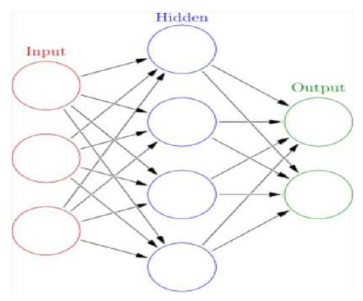
 DownLoad:
DownLoad: 